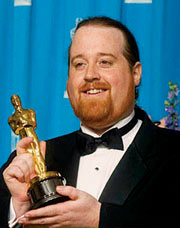  |
 |
|
|
|
||
Send us your news... Support the Arts Any Questions? © UC Santa Cruz |
|
 UCSC alumnus Stephen Mirrione, shown in 2001 with the film editing Oscar he won for his work on Steven Soderbergh’s thriller Traffic. |
Mirrione has previously served as editor for films such as George Clooney’s Good Night and Good Luck, 21 Grams, Ocean’s Eleven, Swingers, and Clockwatchers.
A former UCSC film student who earned his B.A. degree in theater arts from Porter College in 1983, Arata was the New York Times “Critic’s Pick” to win the Oscar in screenwriting. Arata’s writing credits include Spy Game (2001) starring Robert Redford and Brad Pitt, and Brokedown Palace (1999) featuring Claire Danes, Kate Beckinsale, and Bill Pullman.
At the Febrary 25 ceremony, Thelma Schoonmaker and William Monahan received the Oscars for film editing and best screenplay respectively. Both were recognized for their work in “The Departed.”
Alums’ work featured in Architectural Digest
LizAnne Jensen (Crown College, 1978, Art History) and her husband Ken Jensen (Stevenson College, 1973, History), recently had their work featured in Architectural Digest and Fortune Small Business magazines. In 1988, the Jensens co-founded West Coast Weather Vanes, a small collaborative craft studio located in the Santa Cruz Mountains. Together with three other master craftsmen, they create handcrafted copper weathervanes for residential and commercial applications around the world. Clients include the White House, the United States Post Office, Universal Studios, Warner Bros., the Del Mar Racetrack, the Sultan of Brunei, and the Houston Zoo.
West Coast Weather Vanes specializes in custom designs and each weathervane is crafted to individual order. The company has completed more than 600 individual designs, including a Screaming Eagle weathervane for a veteran who flew combat missions in World War II, portrait weathervanes of equestrians on their horses, Zeus hurling a thunderbolt through a storm-laden sky, several banana slug weathervanes (one appears in the Chancellor’s garden and one is atop the Crown College Library) and a gargoyle weathervane (one of which was commissioned for the X-Files and produced by fellow alum Paul Rabwin). For more information, visit www.westcoastweathervanes.com.
Couple creates handbound book documenting papermaking in the Philippines
Peter Thomas (College 5, 1978), a book artist and hand papermaker, works in collaboration with his wife Donna. They have recently written and illustrated a handbound book titled The History of Papermaking in the Philippines. The book is letterpress printed on a text paper handmade by Peter Thomas and features 11 samples of paper handmade by Filipinos from Philippine plants.
The History of Papermaking in the Philippines is the culmination of almost 20 years of work. The book had its genesis in 1986 when Nida Dumsang, visiting from the Philippines, taught a one-day papermaking workshop in Santa Cruz. Peter took the class, learning how to make paper from plants, a thing he had not done before. The couple bought samples of Dumsang’s paper with the thought of making a book to feature the papers that would be accompanied by a short text describing her processes and also a brief history of papermaking in the Philippines.
This was easier said than done, according to the Thomases, who were unable to find any references to Philippine papermaking in any local libraries, the Dard Hunter Paper Museum or the Library of Congress. When they asked Dumsang for information on the subject, she wrote back: “The Philippines had no tradition of written history before the arrival of the white man...historians have found it difficult to piece together facts because there are only the scantiest written records from that era.”
Peter was astonished that there was not a history of papermaking in the Philippines, and the idea of writing the first history of Filipino papermaking called him. He visited the Philippines in February 1990 and later that year the Thomases made a book, Bayad - The story of a trip to the Philippines to discover why there is no history of papermaking in that country, that chronicles the trip.
The History of Papermaking in the Philippines presents information that the couple gathered over the next 10 years (with the help and encouragement of numerous scholars and colleagues). The text includes discussions of the pre-historic precursors to paper, including Philippine bark cloth. It contains a survey of the first printed books made in the Philippines and the paper they were printed on. It documents their research to discover when the first sheet of paper was made in the Philippines. When describing abaca fiber, the text describes how it made Manila hemp rope, and how that was used to make Manila paper. The book ends with a chronological history of both commercial and hand papermaking in the Philippines up to 2000.
For more information about The History of Papermaking in the Philippines and other books created by Peter and Donna Thomas, visit http://www2.cruzio.com/~peteranddonna/index.htm.
Attention UCSC Alumni
Are you interested in reconnecting with your fellow alumni and making new contacts?
Visit the UCSC Alumni Association for more information. There you can find out how to:
• Join the Alumni Association
• Update your contact information
• Become a mentor
• Find fellow alumni
• Find faculty and staff
There are already nearly 10,000 UCSC Alumni Association members. Don’t you think it’s time you joined the Club?